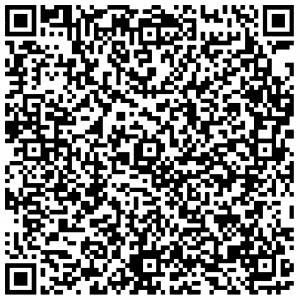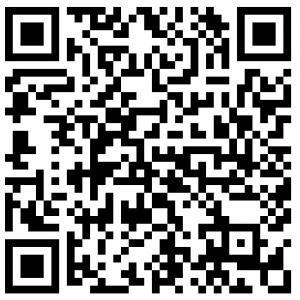FAQ
I already have a QR code on my printed business card. What is the difference to the Digital Business Card?
Paper business cards usually have a QR code printed on them that contains a so-called vCard. This vCard already contains all your contact details. When you scan it, this data is transferred to your smartphone’s contact database. This also works offline, because the QR code contains all the necessary information.
Here is an example of a vCard that can be scanned offline:

The digital business card uses a QR code too. However, this does not contain a vCard, but only a link to an online version of your business card. Therefore, such a QR code can be more compact, i.e. it can also be printed very small on a business card. Since the actual contact data is not stored in the QR code, it can still be changed online after a paper business card has been printed – after all, the link to your Digital Business Card always remains the same.
Here is an example of a QR code with a link to the Digital Business Card:

What is a vCard?
The vCard is a file with a standardized structure that contains a person’s contact data. This facilitates the exchange of contact data between different systems and programs.
vCard files are simple text files technically, but are saved with the extension .vcf (instead of .txt).
Complete vCards can also be wrapped in a QR code. After scanning, downloading and/or double-clicking a vCard, the contact database of a smartphone or PC opens and the contact data contained by the vCard is displayed. You can then save the data to your device with a further click. aloqio provides the contact details of the Digital Business Card holders on the respective webpage in vCard format.
Here is an example of a vCard using version 3.0 (which is also used by aloqio):
BEGIN:VCARD
VERSION:3.0
FN:Max Mustermann
N:Mustermann;Max;;;
ORG:SAMPLE International GmbH
ADR;TYPE=WORK:;;Beispielstrasse 1;Berlin;;10785;
TEL;TYPE=VOICE,WORK:+99 12 345 67 89-013
TEL;TYPE=CELL:+99 111 34567890
EMAIL;TYPE=WORK:m.mustermann@sample-corporation.com
URL:www.sample-corporation.com
END:VCARD
And here the corresponding file for download:
… and the QR code to scan:

Can my Digital Business Card be viewed by anyone on the Internet?
No, not by default. Only those who know the link to your Digital Business Card can access your data. And this link is so long and complex that it cannot be guessed or calculated , e.g. https://aloq.io/c85d1440-eab5-4945-8476-783ade2c09fd
The link therefore does not contain your name in plain text, but a unique code that is usually called up by scanning a QR code or clicking on a link in your email signature.
However, at your express request, we can also configure aloqio for your company so that the URL contains the names of your employees in plain text, e.g. https://aoq.io/sample-max-mustermann. This allows you to access the Digital Business Card even if you do not know a link, but only the name of the person you are looking for.
Does someone who wants to see my Digital Business Card have to register or log in somewhere?
No. Protection against unauthorized access to your data is provided by the above-mentioned unique, complex link that cannot be guessed or calculated.
Can I find out who has accessed my Digital Business Card?
No, you always pass on the same link to your Digital Business Card – there is no personalization with regard to the recipient. However, you can see how often your cards have been accessed in the aloqio Manager.
How do you scan a QR code?
On iPhones with the latest operating system, the scan function is already integrated into the pre-installed camera app. As soon as the camera recognizes a QR code, it analyzes it and displays a target URL to your Digital Business Card, for example. When you click on the link, the website (in this case the webpage with your personal data) is opened. It works in a similar way with Android smartphones; sometimes, however, one of the many free QR code scanning apps available must be started to scan the QR code.
Do I need an app to create or use the Digital Business Card?
No, the aloqio Digital Business Card works purely web-based. An app is not required, neither for creating and editing nor for reading and using the Digital Business Card.
How does the reading of an NFC card or tag work?
If the other person has activated the NFC (Near Field Communication) function on their smartphone, they simply hold their cell phone up to your NFC card or NFC tag – and the web page with your contact details is called up, just like after scanning a QR code.
How is the Digital Business Card data kept up to date?
In the Free version or if your company has provided you with the corresponding authorization in the Enterprise version, you can update your data yourself. You will receive the login required for this either automatically by email after creating your Digital Business Card.
The second option would be for the administrator of your company to carry out the updates for you (available in the Enterprise version).
The third option is an automated data exchange with the corresponding databases of your company. This automatic exchange is an additional option in the aloqio Enterprise version.
Will paper business cards now become obsolete?
In some cases: yes. When, for example, face-to-face meetings are the exception and contact information is shared primarily via email, chat or video conferencing. Even in some personal encounters, the paper business card can be replaced by the electronic version: People scan each other’s QR code or send each other the link to the digital business card. Whether analog or digital exchange is more suitable and efficient depends on the specific situation.
However, most companies see the business card as more than just a means of exchanging contact details. For them, the business card is a way to get creative and communicate a high-quality appearance that can be perceived by multiple senses. Graphic design, high-quality paper, unusual finishes and much more is all part of the corporate designer’s repertoire – and much of this cannot be achieved digitally. What’s more, there are still many situations in which the classic business card exchange is a well-established, popular, bonding ritual – and especially when several people meet, it simply goes faster.
Conclusion: The Digital Business Card is probably more often a supplement than a replacement for the classic business card. If the printed card then has a QR code with a link to the digital card, you have the “best of both worlds”.
Why is aloqio actually called aloqio?
“aloqio” is a slightly alienated variant of the Latin word “alloquor” – it means “to address someone”. And being addressed is one of the most important goals of the Digital Business Card. The speech bubble indicated by the “q” in the lettering also points to this goal: